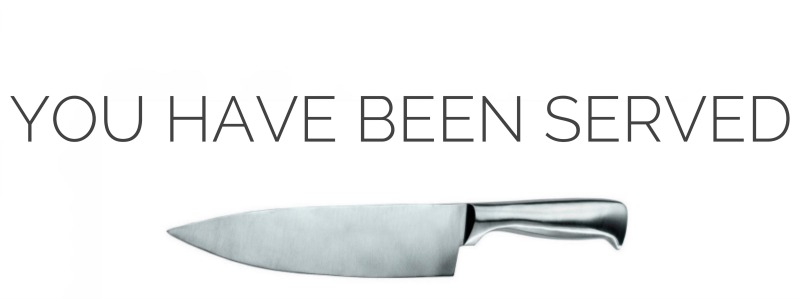Banning Tipping is the New Organic – Part One
Every year, the good folks at Pantone reveal their choice for “color of the year” as determined by a cabal of representatives from various countries’ colour standards groups. I don’t who these people are (it’s a secret), I don’t know their qualifications (also a secret), and I don’t know where or how often they meet (because, secret), but, apparently, they have the ability to absorb and interpret the zeitgeist of the universe and then reduce it to a colour. In reality, however, Pantone’s colour of the year becomes itself the zeitgeist as it is quickly soon after reproduced in fashion, interior and commercial design as the colour of our nail polish, cars, wallpaper, Kleenex boxes, clothes, and so on. “Tangerine Tango”, for instance, is all the rage for a year until “Emerald” comes along, whereupon we must immediately acquire a new wardrobe, if not a new car. Pantone’s “color of the year” set the design world aflutter this past December with the announcement of TWO colours as “color of the year”: Rose Quartz (pale pink) and Serenity (pale blue).
Pantone’s “color of the year” proclamation was accompanied by the to-be-expected corporate bumpf explaining the colour choices. In Pantone’s own words, the colour selections were made to recognize our search for “mindfulness and well-being as an antidote to modern day stresses” and to demonstrate “balance…connection…wellness…[and] a soothing sense of order and peace.” Phew! Stop refilling those Xanax prescriptions everyone and quit your yoga class; instead, just slap a coat of Rose Quartz on your toenails and serenity mission accomplished! Not satisfied with just blissing everyone out, Pantone explained its two colour choices as a reflection of societal change. Rose Quartz and Serenity would “challenge traditional perceptions of color association”, would reflect our experience of “gender blur”, would recognize “societal movements to gender equality and fluidity”, would reveal an “increased comfort with using color as a form of expression”, and would acknowledge a generation’s “concern about being typecast or judged”. That is just awesome. Pantone for President!
Notice that Pantone is not exactly explicitly supporting gender equality or gender fluidity, they are just observing it in their mission to reflect the zeitgeist. In other words, Pantone is employing buzzy, politically correct, jump-on-the-bandwagon doublespeak. We’re still talking about pale pink and pale blue here; it doesn’t get any more stereotypical or binary than that. If Pantone really wanted to show support for gender fluidity, they should have offered up as “color of the year” their entire, every-colour-in-the-rainbow catalogue. I mean, the rainbow has been a symbol of the LGBTQ community for decades. And furthermore, by associating the “color of the year” (which by definition is a short-lived trend) with “gender blur”, is Pantone suggesting that “gender fluidity” is a trend? Or maybe just a social movement they’re prepared to notice for a year until the next zeitgeisty cultural phenomenon and accompanying colour comes along?
Restaurants, like lipstick makers or floral designers, are no strangers to the power and promise of the trend. Ten years ago you couldn’t get a fish taco outside of Mexico and now they’re ubiquitous; you can probably find one at your local convenience store right next to the conveyor belt hot dogs. Some food trends have staying power: bacon, charcuterie, and burgers, for example. Some trends flare and then flame out: think poutine, truffle oil, cupcakes, and civet catshit coffee. Some trends, like old-timey, grandpa cocktails, are just new iterations of old trends. Many of the trends that start in hipster hidey-holes eventually go mainstream and then officially jump the shark once they appear on McDonalds’ menus (I’m talking about you quinoa). Every year, some old food trends die and some new ones appear.
Just like Pantone and its “color of the year”, various self-appointed authorities annually pronounce the food trends for the upcoming year. According to Restaurants Canada, some of the top trends for 2016 are ancient grains, pulses, inexpensive cuts of meat, and craft beer. As far as I’m concerned, however, the biggest trend for 2016 is banning tipping in restaurants. It’s the new bacon-wrapped-charcuterie-fish-taco-burger. It’s a seriously hot topic and it’s blowing up. It’s big – like locavore big, like gluten-free big. Banning tipping in restaurants is the new organic.
Recently, stories about banning tipping have been blanketing newspapers, popular magazines and scholarly journals, television, radio, and social media. Restaurant tipping is an established custom in some countries and has been long proscribed in others, so why the sudden emergence of tipping as a hot button issue? Answer: Danny Meyer.
Danny Meyer opened his first restaurant, Union Square Cafe, in New York City in 1985. He is now CEO of Union Square Hospitality Group (USHG) which owns more than a dozen restaurants, operates a catering and venue hospitality business, provides operational and organizational consulting services, offers public speaking engagements, and delivers public and private wine education and experience events. USHG is a private company but is estimated to have a market capitalization of $1.5 billion. BILLION! USHG makes so much money that they have a Chief Investment Officer who “leads the company’s financing, equity structuring, and capital allocation, as well as investment strategy in hospitality and technology-related businesses”. When Shake Shack, one of USHG restaurants went public last year, the value of its shares more than doubled in their first day of trading, leading to a valuation of Shake Shack in excess of $1.6 billion. Meyer is estimated to have (notionally) added more than $380 million to his wallet on Shake Shack’s IPO alone.
Clearly, Meyer is a very, very rich man. And I don’t begrudge him one bit. Sure, I’m jealous, but I can’t help being impressed by Meyer’s knack for imagining, creating and then shaking the living shit out of the zeitgeist because, in addition to being fabulously wealthy, Meyer is obviously fabulously smart too. Danny Meyer is the ne plus ultra of restaurateurs, the king, a god even. When he speaks, we listen because he is an oracle. So when Meyer announced that he would ban tipping at first one, and then all of his restaurants, we sat up and listened. Meyer is not the first restaurateur to ban tipping; Thomas Keller eliminated tipping at one of his restaurants in 2005. Other American restaurants have previously banned tipping too, although some have reinstated the practice. And, of course, restaurant tipping has long been dispensed with in most of Europe and never even found traction in other parts of the world. But as soon as Danny Meyer did it a lot of other people jumped on board. Banning tipping is no longer a bandwagon, it’s a freight train.
I do not doubt that Meyer’s decision to ban tipping at his restaurants was a fantastically informed one. I don’t imagine that Meyer changes the font on a menu without consulting experts. Meyer’s move to ban tipping was definitely not made lightly, rashly or offhandedly. I expect that many highly-priced and highly-qualified specialists were involved in the decision-making, with lots of pie charts, spread sheets, Power Point presentations, conversations with Manhattan law firms and long-distance telephone calls to Cayman Island bankers.
Meyer would have us believe that the reason he is banning tipping is to reduce wage inequality between servers and cooks. I call bullshit. Meyer himself recently admitted that he is not in favour of a law banning tipping and doesn’t want other restaurants to follow suit because then “we will lose one of the greatest commercial advantages we have”. So how beneficent is Meyer really? Just like Pantone is “pinkwashing” the promotion of Rose Quartz and Serenity, Meyer is “blue collar washing” (I just made that up) what is, in my view, an entirely self-interested business decision. A restaurant is a business like any other, designed to generate profit – never more so than when the restaurant is part of a conglomerate answerable to shareholders and investors, as is the case with USHG. There is no shame in taking any and all legal steps to maximize efficiencies, cut costs and improve the bottom line, and Meyer shouldn’t feel compelled to give his money-making machine a blue collar sheen. Except that Meyer’s blue collar washing is the very thing that has created the headlines and, by Meyer’s own admission, has increased his restaurants’ sales and profits. It’s pure capitalist genius cloaked as crusading socialist justice.
I’m sure Danny Meyer is a nice guy. In addition to being a brilliant restaurateur, he’s probably a magnanimous philanthropist, a devoted family man, a terrific boss and, probably, a scrupulously honest golfer who never takes a mulligan. By all accounts, and even before the allegedly positive repercussions from tip banning are considered, Meyers’ employees appear to be better compensated than most restaurant workers as they may receive insurance, health benefits, restaurant discounts, transit passes and matching retirement plan contributions. Meyer’s theory of “enlightened hospitality” puts his employees at the top of the list of stakeholders ahead of, in descending order, customers, the community, vendors and shareholders. But I don’t believe for one hot second that Meyer is banning tips solely because he’s an all-around good guy who wants wage equality for all. Remember, this is a guy who personally made more than $380 million dollars IN ONE DAY! I don’t doubt Meyer’s bona fides on matters of social justice, but I am convinced that reducing wage disparity is only tangential to the big score.
The under-the-table tipping economy is estimated to be worth $40 billion in the U.S and $4 billion in Canada, annually. Of course, not all the beneficiaries of this economy are servers; other tipped workers include taxi drivers, golf caddies, aestheticians, hotel workers, hairdressers and washroom attendants. Did you notice who isn’t a recipient of any portion of that $40 billion economy? Danny Meyer. Or, for that matter, every other restaurateur.
Let’s assume the average tip on a restaurant bill is 15% (it’s often more and occasionally less). If a restaurant’s annual sales are $1,000,000, tips might represent $150,000 in cash flow to which the restaurateur does not have access or, at least, is not legally entitled. That’s a serious wodge of cash. Accessing that 15% percent on top of a restaurant’s revenue could cover annual rent, or a goodly chunk of labour or food cost. Now, imagine that you have more than a dozen restaurants. Imagine that each of those restaurants has annual revenues of, say, $10,000,000 for combined revenue of $120,000,000. 15% of that revenue is almost $20,000,000. Who wouldn’t want a piece, even just a fraction, of that action?
I believe Meyer’s decision to ban tipping is based upon circumstances unique to New York City. Despite the rapid proliferation of culinary schools and the delusional aspirations of chef wannabes (see my series “If You Can’t Stand the Heat Get Out of the Kitchen”), NYC is experiencing a chef shortage. How does this even make sense? Perhaps all these chefs manqués are discovering that cooking is hard, stressful, dangerous, doesn’t pay very well and, unlike everything they have read and heard, does not involve snorting coke off the bodacious bartender’s boobies. So, how do you attract culinary staff? Meyer tried enticing cooks by offering restaurant discounts, transit passes and matching pension plan payments, only to be met with the complaint that his staff couldn’t make rent never mind a retirement contribution. To attract cooks Meyer would need to pay them more. But rather than quietly find efficiencies, raise prices, or dip into profits, Meyer tapped the tip pool and called it social justice.
Many restaurant servers pool their tips. In other words, every server on a particular shift contributes his or her tips to the pot which is then divvied up between them according to, among other things, hours worked and seniority. The advantage of this system is that it encourages collegiality amongst servers and, as far as a customer is concerned, it means you are unlikely to hear a server respond to your request for more water with “sorry, you’re not in my station”. Enlightened servers and restaurateurs also ensure that a portion of the tip pool is given to kitchen staff and other members of the restaurant team like the hostess, sommelier and coat check person. Sometimes this “tipping out” to the kitchen staff is done informally by passing out $10 or $20 bills to various team members, but more often the restaurant requires that the servers contribute a percentage of their sales for redistribution to other restaurant employees. The tip out might amount to 2%, 5% or even 10% of the restaurant’s sales for any given shift.
Tipping out the kitchen recognizes that the cooks (and dishwashers, busboys, food runners, wine stewards etc.) are part of the team that provides the restaurant customer with a complete dining experience. It helps to lessen the income disparity between the front of house and the back of house. It’s not a perfect system by any means. In the best of all possible worlds every worker on the planet would be paid a living wage. Someone should figure out how to do that; it doesn’t sound hard at all.
In NYC, however, while servers may pool their tips and redistribute the pool amongst themselves, state law prohibits sharing any portion of the tip pool with the kitchen. Banning tipping and instituting a service charge in order to lessen wage disparity doesn’t obviate the law. But adding an administrative fee or increasing prices (a rose by any other name) permits restaurateurs who ban tipping the ability to, essentially, access what would otherwise be the tip pool.
Finally, the minimum wage regime in New York is whack. As of this year, the minimum wage is $7.50/hour for tipped employees (like a server), $9/hour for most employees (like a cook) and $10.50/hour for fast food workers. It’s already more lucrative to work at McDonald’s than be a low level cook in a fine dining restaurant. By 2018, the minimum wage for fast food workers will climb to $15/hour. If there is a cook shortage now in NYC fine dining restaurants, imagine the exodus to Burger King when the minimum wage for a fast food fry cook will far exceed the minimum wage for a Manhattan garde manger.
The move to ban tipping has picked up steam outside of NYC, notwithstanding that circumstances may be different elsewhere. While banning tipping makes sense for Meyer, it doesn’t necessarily make sense for everyone else. In Toronto, for example, some restaurateurs would have you believe that there is a similar cook shortage. That may well be so, but there are other factors at play than just compensation. As my husband (a chef and restaurateur himself) points out, it may be hard to find cooks but it’s not that hard to keep them. Retaining staff isn’t rocket science. In our experience, there are alternatives to taking from Peter to pay Paul: a decent wage, a chance to learn, the opportunity for advancement, respect, comraderie, and expressed gratitude and appreciation. In addition, Toronto restaurants are not constrained from pooling tips with the kitchen staff, either formally or informally. And finally, while the minimum wage in Ontario is likely inadequate, it is still the highest in Canada at (soon to be) $11.40/hour generally and (soon to be) $9.90/hour for servers. Of course, these are minimum wages; any restaurateur with half a brain in his or her head pays experienced and valued employers in excess of the minimum.
Meyer’s decision to ban tips is widely reported as game-changing social justice. Banning tipping will, Meyer assures us, help close the ever-widening gap between FOH and BOH wages. I’ve heard others claim that because tipping is rooted in racism, classism and sexism (since the tipping economy is largely relied upon by women, low income earners and/or people of colour), that banning tipping will ameliorate racism, classism and sexism. Some have argued that instances of sexual harassment faced by female servers will decline when female servers are not tip-reliant because they will no longer have to tolerate harassment from their customers. I’m sorry, but that’s just ridiculous. Men will stop sexually harassing women just because the tip is included? As if. It seems like more of an incentive for harassment if you ask me. Employers are already legally responsible for ensuring that their staff is free from sexual harassment, or else face having their pants sued off and their bare bums pinched. Claiming that banning tipping will reduce sexism, racism and classism is like claiming that racism was solved when Barack Obama became President. Bitch, please. As far as I am aware, even Meyer isn’t claiming to fix racism or sexism by banning tipping. Meyer had the good political and populist sense to model himself after Robin Hood and not Gloria Steinem.
I was at the ballet recently and, while waiting for the lights to dim and the curtain to rise, I perused the programme. In particular, I scanned the part of the programme that lists the financial donors to see if I knew, or knew of, any of them. To my surprise, there were quite a number of anonymous donors, even at the highest levels of monetary contribution. I love this. I love that, for whatever reason, some folks make donations to arts organizations or charitable groups without, presumably, the need for the quid pro quo of name recognition. Maimonides lists anonymous giving as one of the highest levels of charity. Who do some people issue press releases and alert the paparazzi when they visit a children’s hospital, build a school in Mali or issue a giant cheque, while others just quietly and anonymously go about their good work? Well, don’t expect an answer to this question from Danny Meyer who releases public newsletters, holds town hall meetings and gives interviews to the international media when he gives his staff a raise.
The disparity in wages between restaurant FOH and BOH employees has increased over the years. Cooks’ wages have remained fairly stagnant, while servers’ incomes increase as menu prices rise thereby moving the baseline for calculating a server’s tips. Is this fair? Probably not. Despite Meyer’s protestations to the contrary, I don’t believe the real motivation for banning tipping is to reduce the discrepancy between FOH and BOH wages. The bigger picture issue is that average restaurant profit is painfully small, like in the low single digits. Meyer’s move to ban tipping solves three separate complaints: low BOH wages, the supposed “ick factor” of tipping, and razor thin restaurant margins. It’s brilliant. At least for USHG. But does it really make sense for employees, customers and other restaurateurs? I remain unconvinced.
The photo above was created using Pantone’s “color of the year”: Chili Pepper 2007, Tangerine Tango 2012, Mimosa 2009, Emerald 2013, Blue Iris 2008 and Radiant Orchid 2014.
Read Part Two of Banning Tipping is the New Organic…
Listen to this playlist from Bruce Springsteen and make some yummy cornbread…





As much as I want to call bullshit, I don’t think that you’re wrong to suspect that Meyer etal. may have more mercenary and economic reasons for going to service charge vs. tipping. He’s also one of the biggest players in the game, so if anyone can afford to gamble, its him….
But I actually wish you were 100% wrong…It would be nice if someone actually gave a fuck about the line cooks ability to pay his rent, student loans and go to the dentist regularly. Even with a 5% tip out, far above average, cooks still get fucked over compared to the rocket scientists who carry plates to their 10 tables in air conditioned comfort.
You say [your restaurant] has no problem keeping cooks, from all the guys that I know in the GTA, you’re unique. Of the few dozen or so guys I still know in the biz in the GTA, 90% of their servers are inter-changeable and generic. A server quits, they rarely give it a second thought, the other servers happily take their shifts for a few weeks until they train someone new. But cooks, they’re always on the lookout for cooks, 90% of them are always hiring cooks.